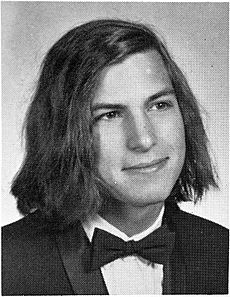Steve Jobs facts for kids
Quick facts for kids
Steve Jobs
|
|
|---|---|
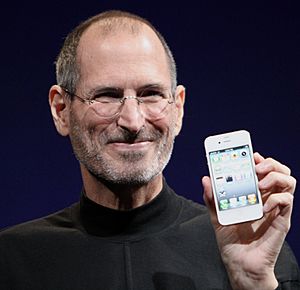
Jobs introducing the iPhone 4 in 2010
|
|
| Born | February 24, 1955 San Francisco, California, U.S.
|
| Died | October 5, 2011 (aged 56) Palo Alto, California, U.S.
|
| Resting place | Alta Mesa Memorial Park |
| Education | Reed College (attended) |
| Occupation |
|
| Years active | 1971–2011 |
| Known for |
|
| Title |
|
| Board member of | |
| Spouse(s) | |
| Partner(s) | Chrisann Brennan (1972–1977) |
| Children | 4, including Lisa and Eve |
| Relatives |
|
| Awards | Presidential Medal of Freedom (posthumous, 2022) |
| Signature | |
Steven Paul Jobs (February 24, 1955 – October 5, 2011) was an American business magnate, industrial designer, media proprietor, and investor. He was the co-founder, chairman, and CEO of Apple; the chairman and majority shareholder of Pixar; a member of The Walt Disney Company's board of directors following its acquisition of Pixar; and the founder, chairman, and CEO of NeXT. He is widely recognized as a pioneer of the personal computer revolution of the 1970s and 1980s, along with his early business partner and fellow Apple co-founder Steve Wozniak.
Contents
Early life
Jobs was born in San Francisco to a Syrian father and German-American mother. Steven Paul Jobs was born on February 24, 1955 in San Francisco, California, U.S., Steve Jobs' mother, Joanne Schieble was American of German and Swiss descent; his father, Abdulfattah "John" Jandali was a Syrian. They wanted Steve to be adopted by college graduates, that was not the case. He was adopted by Paul and Clara Jobs who promised Steve would go to college. Jobs did not contact his birth family during his adoptive mother Clara's lifetime.
Paul and Clara adopted Jobs's sister Patricia in 1957 and by 1959 the family had moved to the Monta Loma neighborhood in Mountain View, California. Paul built a workbench in his garage for his son in order to "pass along his love of mechanics”. Jobs, meanwhile, admired his father's craftsmanship "because he knew how to build anything. If we needed a cabinet, he would build it. When he built our fence, he gave me a hammer so I could work with him … I wasn't that into fixing cars … but I was eager to hang out with my dad." By the time he was ten, Jobs was deeply involved in electronics and befriended many of the engineers who lived in the neighborhood.
He attended Monta Loma Elementary School in Mountain View. Jobs frequently played pranks on others at school. His father Paul never reprimanded him. Instead, he blamed the school for not challenging his brilliant son.
Jobs attended Reed College in 1972 before withdrawing that same year.
Apple

Steve was a Silicon Valley businessman most famous for his work with the company Apple Computer Inc, starting with the release of the Apple I in 1976.
Together with Apple co-founder Steve Wozniak, Jobs helped make the idea of the personal computer popular in the late 1970s. In the early 1980s, still at Apple, Jobs was one of the first to see the potential of using a mouse to control things on a computer screen.
He and Wozniak gained fame and wealth a year later with production and sale of the Apple II, one of the first highly successful mass-produced microcomputers. Jobs saw the commercial potential of the Xerox Alto in 1979, which was mouse-driven and had a graphical user interface (GUI). This led to the development of the unsuccessful Apple Lisa in 1983, followed by the breakthrough Macintosh in 1984, the first mass-produced computer with a GUI. The Macintosh introduced the desktop publishing industry in 1985 with the addition of the Apple LaserWriter, the first laser printer to feature vector graphics.
In 1985, Jobs was forced out of Apple after a long power struggle with the company's board and its then-CEO, John Sculley.
NeXT
That same year, Jobs took a few Apple employees with him to found NeXT, a computer platform development company that specialized in computers for higher-education and business markets.
Pixar
He helped to develop the visual effects industry when he funded the computer graphics division of George Lucas's Lucasfilm in 1986. The new company was Pixar. Jobs sold Pixar to Disney in 2006, and gained a seat on the Disney board of directors. Pixar went on to make numerous hugely successful films, such as Toy Story (1995), Monsters, Inc. (2001) and Cars (2006). Jobs made more money with Pixar than he did while he was with Apple in the 1970s and 80s.
Return to Apple
In 1997, Jobs returned to Apple as CEO after the company's acquisition of NeXT. He was largely responsible for reviving Apple, which was on the verge of bankruptcy. He worked closely with English designer Jony Ive to develop a line of products that had larger cultural ramifications, beginning with the "Think different" advertising campaign and leading to the Apple Store, App Store (iOS), iMac, iPad, iPod, iPhone, iTunes, and iTunes Store.
In 2001, the original Mac OS was replaced with the completely new Mac OS X (now known as macOS), based on NeXT's NeXTSTEP platform, giving the operating system a modern Unix-based foundation for the first time.
Personal life
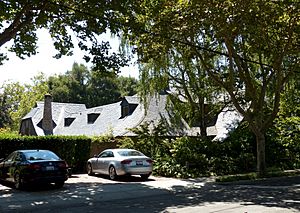
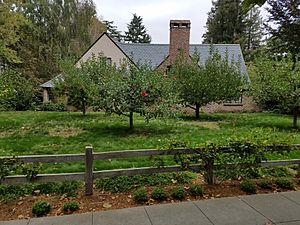
He had a daughter, named Lisa, with his girlfirend, atrist Chrisann Brennan. She was born on May 17, 1978. She is Jobs's first child. For years he claimed that she wasn't his child, but later admitted his fatherhood. Brennan and Jobs had a complicated relationship and were never committed to each other nor broke up.
In 1989, Jobs first met his future wife, Laurene Powell, when he gave a lecture at the Stanford Graduate School of Business, where she was a student. They married on March 18, 1991, in a Buddhist ceremony at the Ahwahnee Hotel in Yosemite National Park. Jobs's and Powell's first child was born in 1991. Jobs and Powell had two more children; Eve Jobs, born in 1998, is a fashion model. The family lived in Palo Alto, California.
When Jobs met his biological mother, he found out that he had a sister, Mona Simpson. They became close. Jobs's biological father never tried to contact him, and they never met.
Health problems and death
In 2003, Jobs was diagnosed with a pancreatic neuroendocrine tumor. In April 2009, Jobs underwent a liver transplant at Methodist University Hospital Transplant Institute in Memphis, Tennessee. Jobs's prognosis was described as "excellent". He died of respiratory arrest related to the tumor in 2011, at the age of 56, with Tim Cook succeeding him as CEO of Apple. Steve Jobs had type 1 diabetes as a child and had problems with insulin when he died.
Childhood friend and fellow Apple co-founder Steve Wozniak, former owner of what would become Pixar, George Lucas, former rival, Microsoft co-founder Bill Gates, and President Barack Obama all offered statements in response to his death.
At his request, Jobs was buried in an unmarked grave at Alta Mesa Memorial Park, the only nonsectarian cemetery in Palo Alto.
Innovations and designs
- Jobs's design was influenced by philosophies of Zen and Buddhism.
- He is listed as either primary inventor or co-inventor in 346 United States patents or patent applications related to a range of technologies from actual computer and portable devices to user interfaces (including touch-based), speakers, keyboards, power adapters, staircases, clasps, sleeves, lanyards, and packages.
- Jobs holds 43 issued US patents on inventions. The patent on the Mac OS X Dock user interface with "magnification" feature was issued the day before he died.
- Since his death, he has won 141 patents, more than most inventors during their lifetimes. He holds over 450 patents in total.
Apple I
Although entirely designed by Steve Wozniak, Jobs had the idea of selling the desktop computer, which led to the formation of Apple Computer in 1976. Both Jobs and Wozniak constructed several of the Apple I prototypes by hand, funded by selling some of their belongings. Eventually, 200 units were produced.
Apple II

The Apple II is an 8-bit home computer, one of the world's first highly successful mass-produced microcomputer products, designed primarily by Wozniak, and Jobs oversaw the development of the Apple II's unusual case and Rod Holt developed the unique power supply. It was introduced in 1977 at the West Coast Computer Faire by Jobs and Wozniak as the first consumer product sold by Apple.
Apple Lisa
The Lisa is a personal computer developed by Apple from 1978 and sold in the early 1980s. It is the first personal computer with a graphical user interface for business users. The Lisa sold poorly, at 100,000 units.
In 1982, after Jobs was forced out of the Lisa project, he took over the Macintosh project, adding inspiration from Lisa. The final Lisa 2/10 was modified and sold as the Macintosh XL.
Macintosh
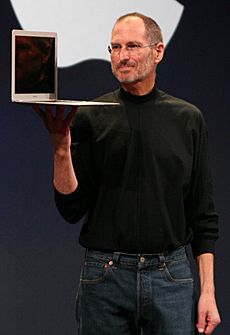
Once he joined the Macintosh team, Jobs took over the project after Wozniak had experienced a traumatic airplane accident and temporarily left the company. Jobs launched the Macintosh on January 24, 1984, as the first mass-market personal computer featuring an integral graphical user interface and mouse. This first model was later renamed to Macintosh 128k among the prolific series. Since 1998, Apple has phased out the Macintosh name in favor of "Mac", though the product family has been nicknamed "Mac" or "the Mac" since inception. The Macintosh was introduced by a US$1.5 million Ridley Scott television commercial, "1984". It aired during the third quarter of Super Bowl XVIII on January 22, 1984, received as a "watershed event" and a "masterpiece". Regis McKenna called the ad "more successful than the Mac itself". It uses an unnamed heroine to represent the coming of the Macintosh (indicated by a Picasso-style picture of the computer on her white tank top) to save humanity from the conformity of IBM's domination of the computer industry. The ad alludes to George Orwell's novel Nineteen Eighty-Four, which describes a dystopian future ruled by a televised "Big Brother."
The Macintosh, however, was expensive, which hindered its ability to be competitive in a market already dominated by the Commodore 64 for consumers, and the IBM Personal Computer and its accompanying clone market for businesses. Macintosh systems still found success in education and desktop publishing and kept Apple as the second-largest PC manufacturer for the next decade.
NeXT Computer
After Jobs was forced out of Apple in 1985, he started NeXT, a workstation computer company. The NeXT Computer was introduced in 1988 at a lavish launch event. Using the NeXT Computer, Tim Berners-Lee created the world's first web browser, the WorldWideWeb. The NeXT Computer's operating system, named NeXTSTEP, begat Darwin, which is now the foundation of most of Apple's products such as Macintosh's macOS and iPhone's iOS.
iMac
Apple iMac G3 was introduced in 1998 and its innovative design was directly the result of Jobs's return to Apple. Apple boasted "the back of our computer looks better than the front of anyone else's." Described as "cartoonlike", the first iMac, clad in Bondi Blue plastic, was unlike any personal computer that came before. In 1999, Apple introduced the Graphite gray Apple iMac and since has varied the shape, color and size considerably while maintaining the all-in-one design. Design ideas were intended to create a connection with the user such as the handle and a "breathing" light effect when the computer went to sleep. The Apple iMac sold for $1,299 at that time. The iMac also featured forward-thinking changes, such as eschewing the floppy disk drive and moving exclusively to USB for connecting peripherals. This latter change resulted, through the iMac's success, in the interface being popularized among third-party peripheral makers—as evidenced by the fact that many early USB peripherals were made of translucent plastic (to match the iMac design).
iTunes
iTunes is a media player, media library, online radio broadcaster, and mobile device management application developed by Apple. It is used to play, download, and organize digital audio and video (as well as other types of media available on the iTunes Store) on personal computers running the macOS and Microsoft Windows operating systems. The iTunes Store is also available on the iPod Touch, iPhone, and iPad.
Through the iTunes Store, users can purchase and download music, music videos, television shows, audiobooks, podcasts, movies, and movie rentals in some countries, and ringtones, available on the iPhone and iPod Touch (fourth generation onward). Application software for the iPhone, iPad and iPod Touch can be downloaded from the App Store.
iPod
The first generation of iPod was released October 23, 2001. The major innovation of the iPod was its small size achieved by using a 1.8" hard drive compared to the 2.5" drives common to players at that time. The capacity of the first generation iPod ranged from 5 GB to 10 GB. The iPod sold for US$399 and more than 100,000 iPods were sold before the end of 2001. The introduction of the iPod resulted in Apple becoming a major player in the music industry. Also, the iPod's success prepared the way for the iTunes music store and the iPhone. After the first few generations of iPod, Apple released the touchscreen iPod Touch, the reduced-size iPod Mini and iPod Nano, and the screenless iPod Shuffle in the following years.
iPhone
Apple began work on the first iPhone in 2005 and the first iPhone was released on June 29, 2007. The iPhone created such a sensation that a survey indicated six out of ten Americans were aware of its release. Time declared it "Invention of the Year" for 2007 and included it in the All-TIME 100 Gadgets list in 2010, in the category of Communication. The completed iPhone had multimedia capabilities and functioned as a quad-band touch screen smartphone. A year later, the iPhone 3G was released in July 2008 with three key features: support for GPS, 3G data and tri-band UMTS/HSDPA. In June 2009, the iPhone 3GS, whose improvements included voice control, a better camera, and a faster processor, was introduced by Phil Schiller. The iPhone 4 was thinner than previous models, had a five megapixel camera capable of recording video in 720p HD, and added a secondary front-facing camera for video calls. A major feature of the iPhone 4S, introduced in October 2011, was Siri, a virtual assistant capable of voice recognition.
iPad
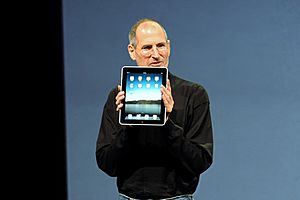
The iPad is an iOS-based line of tablet computers designed and marketed by Apple. The first iPad was released on April 3, 2010. The user interface is built around the device's multi-touch screen, including a virtual keyboard. The iPad includes built-in Wi-Fi and cellular connectivity on select models. As of April 2015[update], more than 250 million iPads have been sold.
Philanthropy
Shortly after leaving Apple, he formed the charitable Steven P. Jobs Foundation, but closed the foundation with no results. Jobs has declined to sign The Giving Pledge, launched in 2010 by Warren Buffett and Bill Gates for fellow billionaires. He donated $50 million to Stanford hospital and contributed to efforts to cure AIDS. Bono reported "tens of millions of dollars" given by Apple while Jobs was CEO, to AIDS and HIV relief programs in Africa, which inspired other companies to join.
Honors and awards
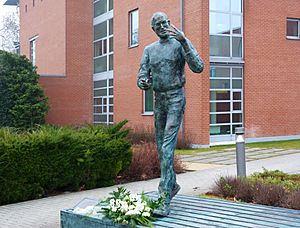
- 1985: National Medal of Technology (with Steve Wozniak), awarded by US President Ronald Reagan
- 1987: Jefferson Award for Public Service
- 1989: Entrepreneur of the Decade by Inc.
- 1991: Howard Vollum Award from Reed College
- 2004–2010: Listed among the Time 100 Most Influential People in the World on five separate occasions
- 2007: Named the most powerful person in business by Fortune magazine
- 2007: Inducted into the California Hall of Fame, located at The California Museum for History, Women and the Arts
- 2012: Grammy Trustees Award, an award for those who have influenced the music industry in areas unrelated to performance
- 2012: Posthumously honored with an Edison Achievement Award for his commitment to innovation throughout his career
- 2013: Posthumously inducted as a Disney Legend
- 2017: Steve Jobs Theater opens at Apple Park
- 2022: Posthumously awarded the Presidential Medal of Freedom by US President Joe Biden, the country's highest civilian honor
Steve Jobs quotes
- "Of all the inventions of humans, the computer is going to rank near or at the top as history unfolds and we look back. It is the most awesome tool that we have ever invented."
- "I always thought of myself as a humanities person as a kid, but I liked electronics… then I read something that one of my heroes, Edwin Land of Polaroid, said about the importance of people who could stand at the intersection of humanities and sciences, and I decided that's what I wanted to do."
- "My favorite things in life don't cost any money. It's really clear that the most precious resource we all have is time."
- "Great things in business are never done by one person. They're done by a team of people."
- "Sometimes life hits you in the head with a brick. Don't lose faith."
- "Technology is nothing. What's important is that you have a faith in people, that they're basically good and smart, and if you give them tools, they'll do wonderful things with them."
Interesting facts about Steve Jobs
- As a child, Jobs had difficulty making friends with children his own age and was seen by his classmates as a "loner".
- He took part in ballet as a child.
- Jobs had difficulty functioning in a traditional classroom, resisted authority figures, frequently misbehaved, and was suspended a few times.
- He credited his fourth grade teacher with kindling a passion in him for learning things.
- Jobs skipped the 5th grade and transferred to the 6th grade at Crittenden Middle School in Mountain View.
- Jobs was often "bullied" at Crittenden Middle, and in the middle of 7th grade, he gave his parents an ultimatum: either they would take him out of Crittenden or he would drop out of school.
- In his youth, Jobs' parents took him to a Lutheran church.
- When he was 13, in 1968, Jobs was given a summer job by Bill Hewlett (of Hewlett-Packard) after Jobs cold-called him to ask for parts for an electronics project.
- Jobs dropped out of college after several months.
- He studied Zen Buddhism in India. He maintained a lifelong appreciation for Zen and engaged in lengthy meditation retreats at the Tassajara Zen Mountain Center, US.
- The three-bedroom house on Crist Drive in Los Altos, California) where Steve Jobs lived with his parents was declared a historic site in 2013, as the first site of Apple Computer.
- Jobs's childhood home remains a tourist attraction and is currently owned by his stepmother (Paul's second wife), Marilyn Jobs.
- He had a public war of words with Dell Computer CEO Michael Dell, starting in 1987, when Jobs first criticized Dell for making "un-innovative beige boxes".
- Jobs usually went to work wearing a black long-sleeved mock turtleneck made by Issey Miyake, Levi's 501 blue jeans, and New Balance 991 sneakers.
- Jobs was a board member at Gap Inc. from 1999 to 2002.
- He never showed an interest in his Syrian heritage or the Middle East.
- Although a billionaire, Jobs made it known that, like Bill Gates, he had stipulated that most of his monetary fortune would not be left to his children. He had limited his children's access, age appropriate, to social media, computer games, and the Internet.
- He was a Democrat and a supporter of Barack Obama. Jobs also once said that he voted for Ronald Reagan.
- Jobs has been played by American actor Ashton Kutcher in the 2013 biopic movie Jobs and by German-born Irish actor Michael Fassbender in the 2015 movie Steve Jobs.
Images for kids
-
A prototype of the original Macintosh from c. 1981 (at the Computer History Museum)
-
Jobs demonstrating the iPhone 4 to Russian President Dmitry Medvedev on June 23, 2010
-
Flags flying at half-staff outside Apple HQ in Cupertino, on the evening of Jobs's death
-
Jobs unveiling the iPhone at MacWorld Conference & Expo on January 9, 2007
- Bill Gates, founder of Microsoft
- Mark Zuckerberg, founder of Facebook
- Jeff Bezos, founder of Amazon
See also
 In Spanish: Steve Jobs para niños
In Spanish: Steve Jobs para niños



